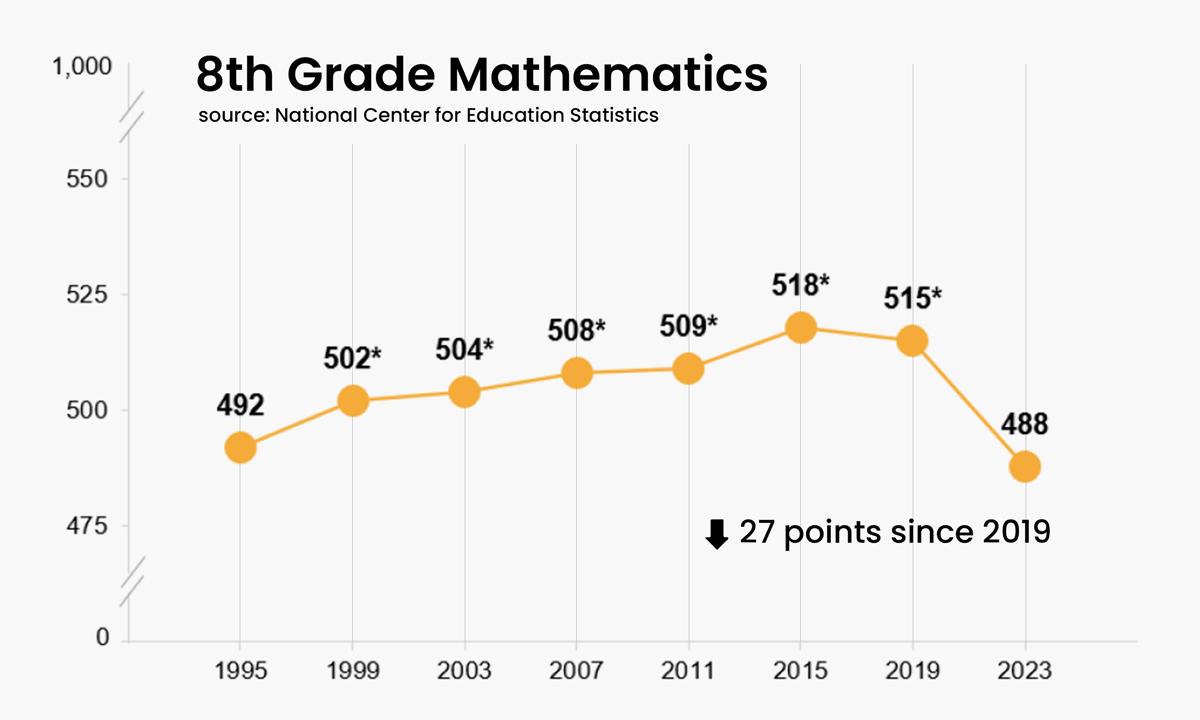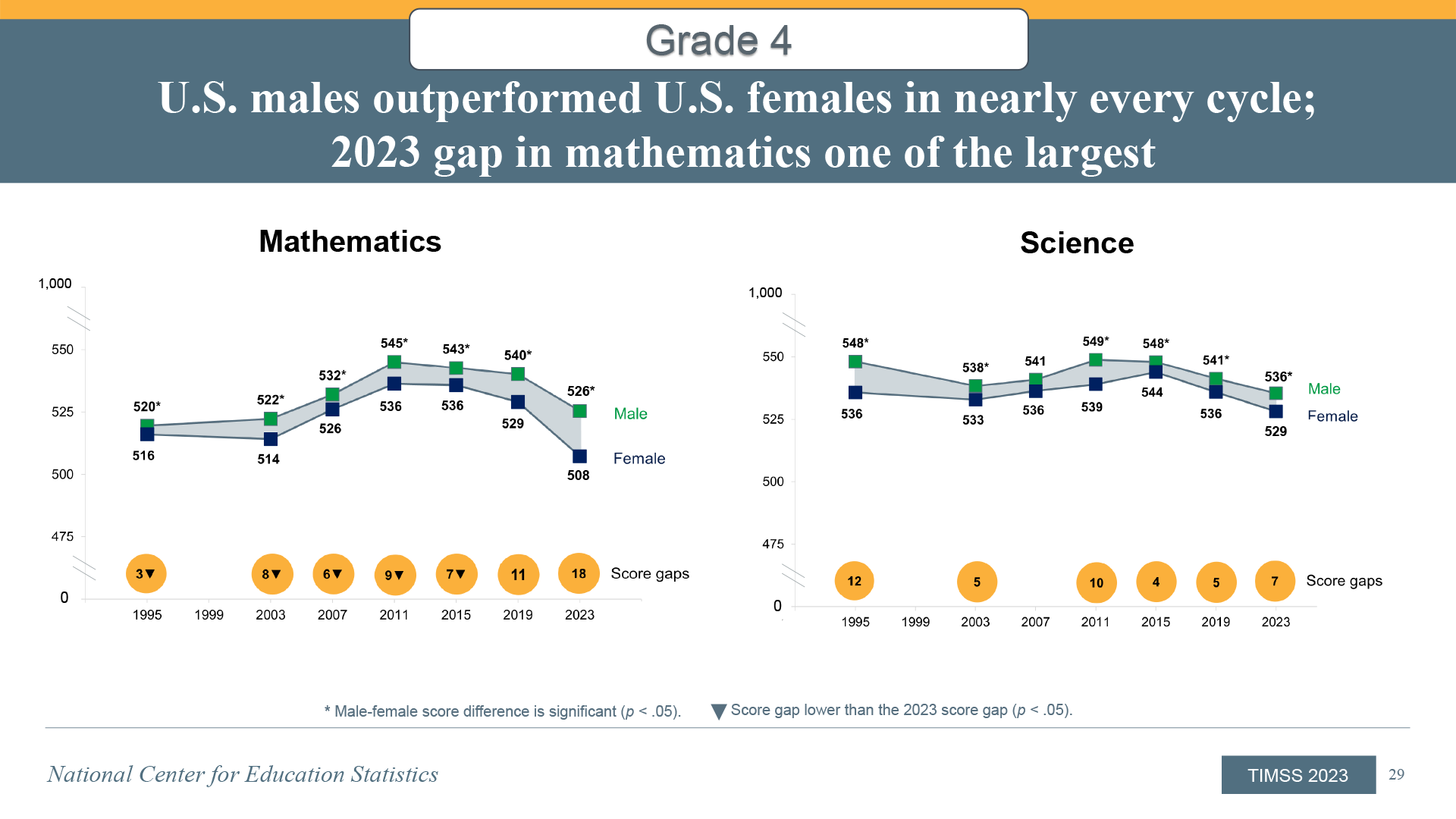Four Insights into U.S. Students’ Drop in Math & Science on International Test
Wednesday's release of TIMSS scores shows that American students fell behind their international peers during the pandemic.

Get stories like this delivered straight to your inbox. Sign up for The 74 Newsletter
International testing data released Wednesday offered the latest evidence of U.S. learning loss since the pandemic, with American students falling behind some of their European peers and a gender gap re-emerging between boys and girls in STEM disciplines.
The scores are taken from the Trends in International Mathematics and Science Study (TIMSS), a carefully watched assessment administered across dozens of countries every four years. The latest results were collected in 2023, with hundreds of thousands of students participating around the world.
In the United States, fourth and eighth graders performed much worse in math last year than students at the same age levels did in 2019; average scores in the subject fell to the level seen in 1995, the first time TIMSS was conducted. Science scores were statistically unchanged over the four-year period, and academic reversals were especially noticeable among struggling students compared with higher-achieving ones.
The results underline the persistent and complex challenge awaiting both local educators and the incoming Trump administration over the next few years. Supported by nearly $200 billion in federal emergency aid, states and districts have launched ambitious programs to combat the academic and social-emotional deficits triggered by COVID-related school closures. Several wide-ranging studies have suggested that those efforts met with only incomplete success, with the cost of a full recovery likely to exceed what has already been spent.
Thomas Dee, an economist at Stanford University, said the dispiriting figures “shouldn’t be surprising to anyone who’s been paying attention.”
“To see nearly three decades of math achievement growth evaporate over the comparatively short time since the pandemic is incredibly sobering,” Dee wrote in an email. “This evidence that we are falling behind other nations over this period further underscores that the U.S. is failing to meet the challenges of academic recovery.”
Four broad findings stand out from the TIMSS release.
Math Achievement Sent Back to the Clinton Era
Previous standardized tests, whether administered at the federal or international level, have all pointed to a dreary parabola in American students’ academic achievement over the past few years: Scores crept upward throughout the 1990s and 2000s, only to stall at some point over the last decade and finally collapse backward during the pandemic.
To see nearly three decades of math achievement growth evaporate over the comparatively short time since the pandemic is incredibly sobering.
Thomas Dee, Stanford University
The same pattern is at play in the TIMSS results, which show math scores peaking in 2011 for fourth graders and 2015 for eighth graders. Between 2019 and 2023, fourth graders’ scores dropped by 18 points, while eighth graders — who would have been learning their foundational math skills at the point when COVID first shuttered schools in 2020 — saw a staggering 27-point drop.
That means that the average test-taker did not perform any better than they did in 1995. Science scores, which have not seen as much upward movement as math results, also fell compared with their mid-2010s high points; fourth-graders now score nine points lower in the subject than they did nearly 30 years ago.
In all, 18 percent of eighth graders and 13 percent of fourth graders failed to hit the lowest achievement threshold on the TIMSS math test, indicating that they lacked even minimal proficiency in the subject. The proportions of ultra-low-performers were, respectively, twice and three times higher than they were in 2011.
Tom Loveless, a veteran education researcher who formerly led the Brookings Institutions Brown Center on Education Policy, argued that the pronounced dip in achievement was a long time in the making.
“One trend I’m becoming more and more confident of: U.S. slippage began before COVID,” he wrote in an email. “The pandemic merely cemented a lot of these declines in place.”
We’re Falling Behind Other Countries
America was hardly alone in grappling with pandemic-related academic reversals. The effects of COVID-19 were felt in education systems the world over, and governments adopted a variety of public health and education responses. At least one previous test, last year’s Program for International Student Assessment, found that while American schools sustained heavy losses in multiple subjects, its rankings among other nations actually improved during the pandemic — a reflection of the more severe setbacks in other countries.
This year’s TIMSS paints a different picture. While students in over a dozen countries experienced declines much like those in the United States, a similar number gained momentum in either math or science. Four countries that had ranked below the United States in fourth-grade math in 2019 (Poland, Bulgaria, Sweden, and Australia), as well as three that had ranked roughly identically (Finland, Czechia, and the Netherlands) all leapfrogged the U.S. this time around.
It’s unclear what differences may account for the progress those countries made relative to the U.S. — though many will undoubtedly wonder if their respective approaches to school closures and virtual instruction played a role. Sweden, in particular, was quick to reopen its K–12 facilities after the first COVID wave in the spring of 2020.
In a call with reporters, National Center for Education Statistics Commissioner Peggy Carr said the phenomenon is “a particularly troubling way in which the U.S. is an outlier compared to other countries.” Among 29 education systems that participated in both the 2011 and 2019 iterations of TIMSS, she added, the U.S. was the only one that saw widening score gaps between top and bottom-scoring students in both subjects and both grade levels.
I’d be very curious to see the correlation between the 2019–2023 change and the amount of remote learning that students received.
Dan Goldhaber, CALDER
“It’s a bit shocking to me that scores went up between 2019 and 2023 in a bunch of countries,” Dan Goldhaber, a veteran researcher and the director of the Center for Analysis of Longitudinal Data in Education Research, wrote in an email. “I’d be very curious to see the correlation between the 2019–2023 change and the amount of remote learning that students received at the country level during the pandemic.”
Struggling Students Are in Trouble
One of the most consistent findings in prior U.S. assessments has been the ominous pattern of low-performing students — those scoring in the bottom 10 percent of test takers — losing ground faster than their higher-achieving peers. The U.S. Department of Education’s NAEP exam, often referred to as the Nation’s Report Card, has consistently shown evidence of the widening gap in performance over the last decade.
A similar trend can be detected in the TIMSS data, with struggling fourth-graders dropping by 37 points in their math scores between 2019 and 2023, and an astonishing 56 points since their scores hit their highest recorded level in 2011. Among all grade-subject combinations, only in eighth-grade math did relatively high performers sustain more academic harm during COVID than relatively low performers.
Goldhaber said that he had encountered “a lot of speculation” about the bifurcating patterns of achievement in recent years, but that changes in federal accountability law at the middle of the last decade may have had a particularly harmful impact on students who were already behind.
“I think it’s likely a combination of the basic end of strict school accountability…along with the hangover from the Great Recession, which clearly impacted individuals and families differently along the income distribution,” he wrote
The Gender Gap is Back
Across all previous iterations of TIMSS, male fourth-graders have tended to slightly outperform their female counterparts. Strikingly, boys in 2023 scored higher than girls in both subjects and both grade levels.
For fourth graders, the male-female disparity in math swelled to 18 points in math and seven points in science between 2019 and 2023. Meanwhile, eighth graders saw a significant gender gap in math for the first time since 2003 — mostly the result of girls’ scores plummeting by 36 points in just four years.

Loveless called the re-assertion of gender gaps in this iteration of TIMSS “fascinating.”
“In a way, it’s in sync with [an effect] seen across other gaps: Everybody lost, but groups historically associated with academic struggles lost more.”
Get stories like these delivered straight to your inbox. Sign up for The 74 Newsletter

;)


